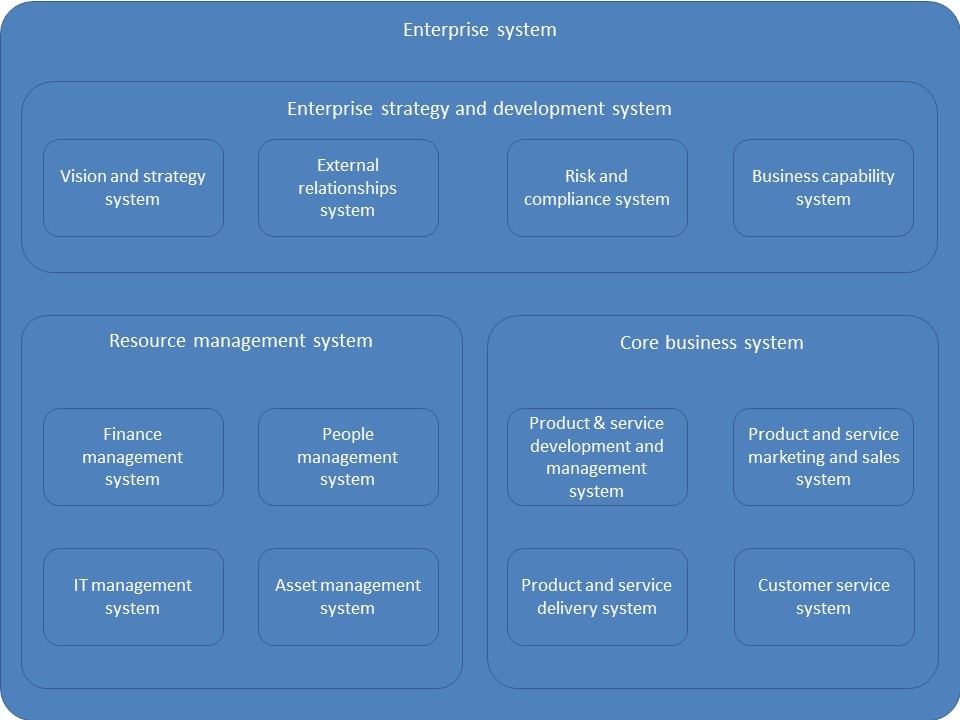Enterprises as systems … Enterprises as systems of systems (or systems squared) … Makes sense! Seems reasonable! But what does it really mean? How does it help in making sense of the enterprises in which we engage and the change or transformation required to realise the goals and aspirations of our enterprises?
A system of systems sounds like it is a hierarchy of systems embedded in systems. Closer inspection indicates that it is more complex than that!
Sole trader or freelancer
An interesting starting point is provided by considering a sole trader or freelancer – a one person enterprise. That should be simple! What systems are encompassed within their enterprise-as-a-system? Likely candidates include:
- Business development system
- Contract management system
- Financial management system
- Work management system
- Service delivery system
How do each of these relate to the others? How should they relate to each other? How might they be organised to readily support enterprise development and growth?
Even for a sole trader, key principles and models are helpful in establishing an effective operating model which supports future enterprise flexibility, agility and growth.
Professional services enterprise
For several different professional services enterprises, I have used the APQC Process Classification Framework as a reference model for likely systems in their enterprise. An example of what this might look like is shown in the following figure.

Whilst this is portrayed as a systems hierarchy with systems composed of subsystems, it is evident on closer consideration that the system relationships are more complex than this.
For example, every executive, manager and supervisor exercises the people management system. In fact, every employee is part of the people management system. Hence, customer service staff and customer service managers are part of both, the customer service system and the people management system. Effective operation of the customer service system, as with all other systems, is dependent on a range of subsystems, including:
- people management system
- finance management system
- IT management system (if IT systems are relied upon as part of customer service operations)
- asset management system (for office and other assets which might be used)
Similarly, any enterprise subsystem could be subject to change and improvement. In such situations, elements of the business capability management system (eg. program management or project management) may be exercised in effecting improvements to the relevant enterprise subsystem.
With various of these system interdependencies in play, it is critical in planning and executing any improvement initiative for one or more enterprise subsystems, that clarity is established as to:
- the subsystem(s)-of-interest
- the containing system(s) of which the subsystem-of-interest may be part
- the embedded systems which may be part of the subsystem-of-interest
Supporting technology systems
Many organisations have subsystems which are dependent on supporting technology systems, where technology encompasses any entity other than people which represents and enables the application of embedded processes. Examples of subsystems using technology include:
- manufacturing production subsystems which operate production lines, robots, and other machinery
- hospital intensive care subsystems which use highly sophisticated medical monitoring and life support technology
- the vast array of organisations that use IT systems to support finance management subsystems, people management subsystems, customer management subsystems and other enterprise subsystems
This extends the system-of-systems line of thinking into addressing more complex networks of people-based-systems (soft systems) and technology-based-systems (hard systems). This enables consideration of:
- subsystems composed of a combination of soft and hard systems
- differing relationships and dependencies, where a single technology-based-system might provide support to multiple people-based-systems and a single people-based-system may be reliant on multiple technology-based-systems
- application of differing methods required to deal with soft systems versus hard systems
It is in situations of complexity that architectural methods are applied to enable multiple stakeholders and multiple solution design and delivery roles to develop shared views and deliver solution components that can be integrated into the full system-of-systems. This is where various forms of abstraction are applied to consider the parts of the enterprise requiring change and improvement, including:
- inclusion and exclusion of subsystems
- composition and decomposition of subsystems
- generalisation and specialisation of subsystems
These issues are explored in other articles, including:
Article by channel:
Everything you need to know about Digital Transformation
The best articles, news and events direct to your inbox
Read more articles tagged: Featured, Operating Model







